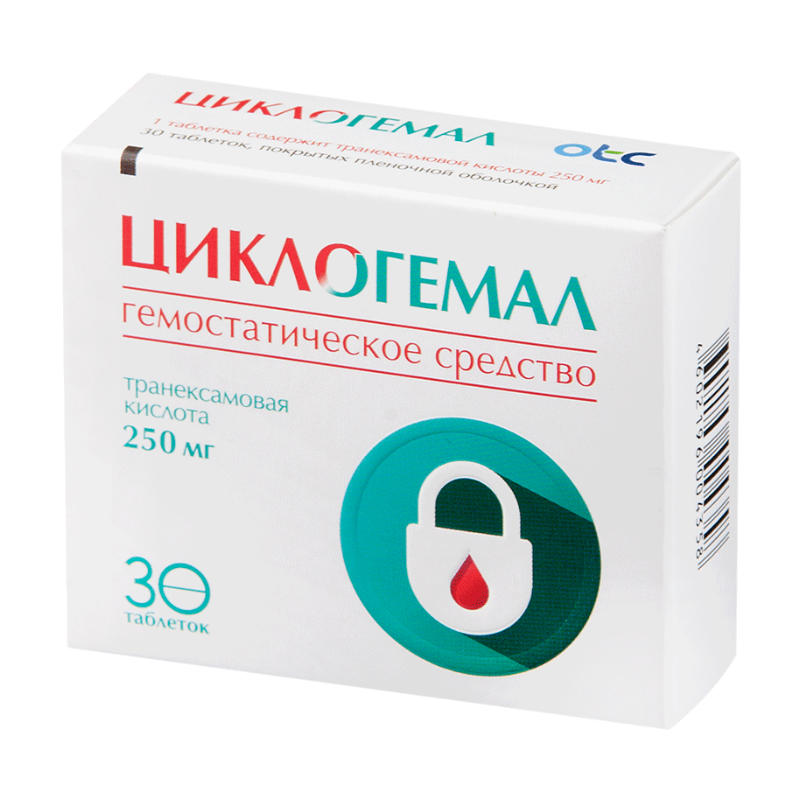



Antifibrinolytic agent. Inhibits the action of plasmin and plasminogen activator, has a hemostatic effect on bleeding associated with increased fibrinolysis, as well as antiallergic and anti-inflammatory effect due to the suppression of the formation of kinins and other active peptides involved in allergic and inflammatory reactions.
Individual, depending on the clinical situation. A single dose for oral administration is 1-1.5 g, the frequency of application is 2-4 times / day, the duration of treatment is 3-15 days. A single dose for the on / in the introduction of 10-15 mg / kg. If you need to re-use, the interval between each injection should be 6-8 hours. In case of violation of the excretory function of the kidneys, correction of the dosage regimen is necessary: when the level of serum creatinine in the blood is 120-250 μmol / l, oral administration is 15 mg / kg, and IV 10 mg / kg 2 times / day; when the level of serum creatinine is 250-500 μmol / l, by mouth and iv, in the same single dose, the multiplicity is 1 time / day; when the level of serum creatinine is more than 500 mcmol / l - orally 7.5 mg / kg, i / v 5 mg / kg, the multiplicity is 1 time / day.
Treatment and prevention of bleeding due to increased overall fibrinolysis (malignant neoplasms of the pancreas, prostate gland; operations on the chest organs; postpartum hemorrhages; manual separation of the afterbirth; leukemia; liver diseases; complications of streptokinase therapy) and local fibrinolysis (uterine, nasal, gastrointestinal hemorrhages, hematuria, hemorrhages after prostatectomy, cervix conization for carcinoma, tooth extraction in patients with hemorrhagic diathesis).
Hereditary angioedema, allergic diseases (eczema, allergic dermatitis, urticaria, drug and toxic rash).
Inflammatory diseases of the oral cavity (stomatitis, aphthous mucosa), pharynx (tonsillitis, pharyngitis, laryngitis).
pills, film coated white or almost white, round, biconvex; on a cut of white or almost white color.
| 1 tab. | |
| tranexamic acid | 250 mg |
Excipients: microcrystalline cellulose - 45.05 mg, pregelatinized starch - 4.85 mg, sodium carboxymethyl starch - 6.2 mg, talc - 7.99 mg, colloidal silicon dioxide - 6.01 mg, sodium stearyl fumarate - 9.9 mg.
Shell: VIVACOAT® RA-1R-000 [hypromellose 6 cPs (hydroxypropylmethylcellulose 6sPz) - 3.51 mg, titanium dioxide - 2.7 mg, polydextrose (E1200) - 1.35 mg, talc - 0.9 mg, polyethylene glycol-3350 - 0.54 mg] - 9 mg.
Tranexamic acid is marketed under different brands and generic names, and comes in different dosage forms:
| Brand name | Manufacturer | Country | Dosage form |
|---|---|---|---|
| pills | |||
| Tranexam | Obninsk HFK | Russia | pills |
| Tranexam | Moscow Endocrine Plant | Russia | solution |
No customer reviews for the moment.
On the part of the digestive system: loss of appetite, nausea, diarrhea, heartburn.
From the side of the central nervous system: drowsiness, impaired color vision.
Allergic reactions: including skin rash, itching. From the digestive system: loss of appetite, nausea, diarrhea, heartburn.
From the side of the central nervous system: drowsiness, impaired color vision.
Allergic reactions: including skin rash, itching.
Increased sensitivity: Increased sensitivity to tranexamic acid. To tranexamic acid.
With simultaneous use with hemostatic drugs and hemocoagulase possible activation of thrombus formation.
The solution can not be added to blood products and solutions containing penicillin.
Caution should be used in combination with heparin and anticoagulants in patients with coagulation disorders and thrombosis (cerebral thrombosis, myocardial infarction, thrombophlebitis) or the threat of their development.
Before and during the treatment, an ophthalmologist should be consulted (determination of visual acuity, color vision, condition of the fundus).
Studies and clinical trials of Tranexamic acid (Click to expand)